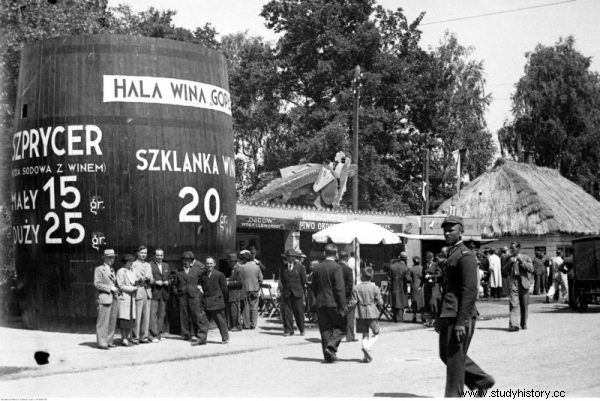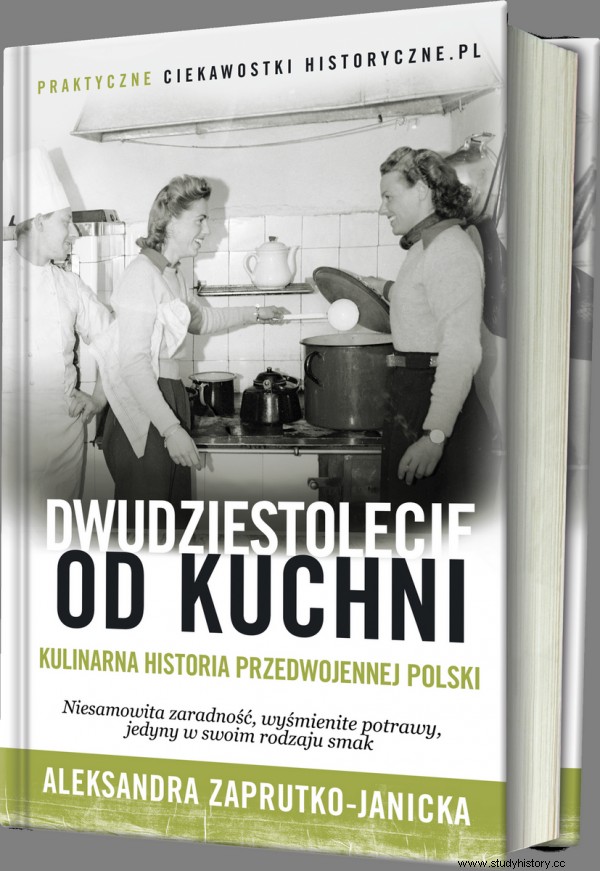Tiny sandwich stalls, a cart from which you can buy hot soup, a food truck with insanely fragrant sausages? No, this is not a fashionable culinary festival, but the everyday life of pre-war Polish streets. If our great-grandparents felt a little hungry in the city, they had a lot to choose from!
In pre-war Poland, there were a huge number of pubs, from the worst murder houses, where the leg stuck to the floor overgrown with dirt, to the most elegant premises, with silver-plated cutlery and crystal chandeliers. Our great-grandparents, however, did not allow four walls of buildings to confine them.
It was enough to have a couple of boards, two billy goats and a schoolboy and you could start your own food business at a fair or marketplace. A crooked table and makeshift benches made it possible to seat possible guests, and a simple denatured alcohol cooker made it possible to reheat previously prepared dishes or to boil water for tea or coffee. It really didn't take any more.
Street food that is wildly fashionable today, with lots of open-air mobile restaurants serving cuisine from all over the world, is not a new invention. Although before the war it was impossible to go to the food truck rally in the parking lot of the shopping center, there were plenty of street eateries. Technological development has made the task much easier for enterprising "restaurateurs". And although the well-to-do looked at such pubs with contempt, the poorer and overworked greeted them with enthusiasm.
Volatile pubs for everyone
The moving restaurants had no signboards, no headquarters, no manager or waiters, but they attracted crowds of hungry customers. They were usually run by poor women with a bit of a business sense.

Stalls at the Krakow Days 1938 fair. Visible, among others, is a stand with a barrel-shaped spritzer. In modern Krakow, you can buy mulled wine from a similar barrel on the market square. As you can see, not much has changed in this regard.
In the simplest edition, to open the "place" you needed a basket lined with straw and rags, into which you put steaming sagans with food, a decent spoonful, just any "tableware" and you could earn money. The scraps of material were supposed to keep the food at the right temperature, and the bowls, plates and wooden spoons usually did not even need to be washed, because customers, out of hunger, emptied them thoroughly and licked them clean.
What did such a "street food" stand look like? He was far from the hipster stalls at contemporary culinary festivals. There were two options - the woman either sat down on a stool and placed pots of food in a circle, to which she reached for consecutive portions, or placed the dishes on a trolley or a makeshift table.
The owner, the chef, buffet and waitress skilfully puts on one hand with one hand and counts the money flawlessly with the other. Even the familiar ragged men who drink every free penny can not count on any discounts, let alone food on credit. Payment is always taken in advance - the guest gets exactly what he can afford.

Incredible resourcefulness, delicious dishes, unique taste. Learn about the female history of pre-war Poland in the book "Twenty years from the kitchen" by Ola Zaprutko-Janicka.
Non-Hisptian menu
Thanks to open air restaurants, which appeared at large crowds of people (markets, fairs, etc.), between dealing with a million errands, it was possible to stop for a moment and not waste too much time, to eat. So what was served in such places? The menu has never been particularly varied.
When it comes to drinks, you could drink coffee, tea, and when poverty pressed, there was still some erzac, which is a cheaper and worse substitute for the above-mentioned. In addition, in the steaming pots of "restaurateurs" you could find ordinary borscht with potatoes, tripe, groats, sausage, some giblets, broad beans, black pudding and other simple specialties. It was enough to grab a piece of bread.
Sometimes enthusiasts of such a small gastronomy got into quite a trouble at the same time, but not because of their fondness for open-air restaurants. An example is the fate of a certain Stanisław Kotlarski from the Łęczyca poviat, who in his part was known as a decent citizen. When he went to the capital to revel, he forgot a bit.

Emes cooker advertisement. The manufacturer suggested using it at the summer resort, but street restaurateurs had their own use for it. It allowed customers to prepare freshly brewed coffee in a few moments, or serve hellishly hot soup.
It started innocently - he decided to try sausages sold on the street. As reported by the columnist of the "Last News" in 1931 in an article devoted to his little adventure:
Walking down Krakowskie Przedmieście, he approached a "volatile restaurant" specializing in sausages [...]. Kotlarski, with a big face, demanded a sausage, and, having received the desired delicacy, ate it with appetite. At that moment, three girl-girls approached the citizen (...). One of them, apparently enormously enterprising, bit off a piece of heart-shaped cheese eaten by Kotlarski. The latter was offended, but after a while he realized that it was a love taunt.
He demanded a new batch of sausages and, putting one in her mouth, let the girl chew on the sausage on the other side. When the sausage was finally consumed, the couple started kissing.

Indulgence fair on St. Kazimierz, the so-called Kaziuki in Vilnius in 1931. A real street cafe, with a samovar, tea drunk in cups, buns, buns and donuts. Just in time to eat after a traditional mass.
At first glance, it would seem that the journalist described the romantic scene, as if from the Disney's Mongrel in love in which two cute little dogs eat one strand of spaghetti which leads to a kiss. Only the story from The Last News has a sequel. After passionate kisses with one lady, Stanisław started to hug her two friends. In the middle of the street.
It is not known how the accidents would have fared and how many sausages would have been eaten, had it not been for the intervention of the police patrol. The Criminal Code of that time contained a paragraph on the penalty of imprisonment for committing a public whoredom. Passionate kisses alerted law enforcement. It has always seemed to me that the level of romanticism of sausages oscillates around that of fat brawn or pork tongues. As you can see, some Poles had their own opinion on this subject before the war ...
***
Incredible resourcefulness, delicious dishes, unique taste. Get to know the female face of the Second Polish Republic. From the culinary side and more! Today buy your own copy our latest book: "Twenty years from the kitchen. Culinary history of pre-war Poland ”by Aleksandra Zaprutko-Janicka. Order your copy at a discount on empik.com.
Sources:
The article is based on the sources and literature used by the author while working on the book "Twenty years from the kitchen. Culinary history of pre-war Poland ” . Full bibliography in the book. And the book itself - in our bookstore.
